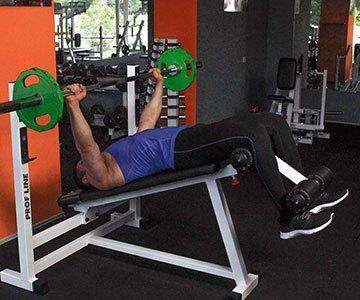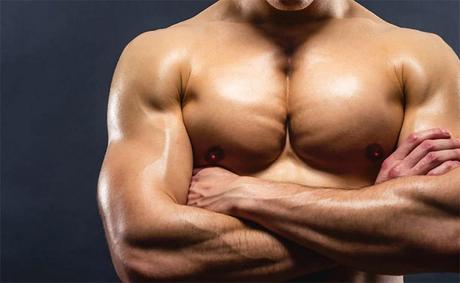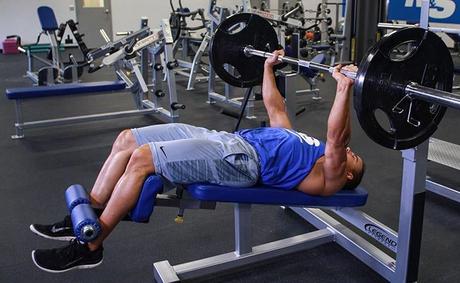As an average gym-goer, one of the greatest mistakes which we do make while at the gym is failing to seek clarification on the various ways in which the gym machines are used. When most of us go to the gym to carry out our training, we will always pretend that we are the all-knowing weight lifter and we do have clues on the ways of using all the weights and benches at the gym. This all-knowing attitude denies us the opportunity to ask important questions when it comes to training. One of the unasked questions at the gym is the importance of the decline bench press.
An Introduction to Decline Bench

One of the unpopular variations of the bench press is the decline bench press. People will arrive at the gym to either work on a flat bench press, an incline bench press and ignore the decline bench press for their own reasons. Sometimes we don’t even ask “which is better incline or decline bench?” When you get to the gym, you will see the decline bench stacked at the corner. No one is interested in it. So what should you do?
Before I inform you why you should immediately jump into the decline bench press at the corner of the gym, I saw it is wise to help you understand the working of your pectoral muscles. It will help you to carry out the perfect decline bench press.
Pectoralis Major
It is the biggest of all the three chest muscles and it controls the movement of your arm towards the chest. Pectoralis major begins at the ribs and attaches itself to the upper arm. In women, the muscle is found just beneath the breast tissue.
When working out in the gym, your goal should be to always ensure that you are having a thick fan-shaped pectoralis major. There are different exercises which you can carry out to have a perfect pectoralis major muscle.
Pectoralis Minor
It is a thin and flat muscle found below the pectoralis major and it is one of the pectoral muscles which people avoid. However, if you are looking out for a way of having a strong chest, then you should make pectoralis minor a priority when you are working out at the gym.
Most of the swimmers have well-developed pectoral muscles since they carry out the front crawl stroke which develops the pectoralis minor. On the other side, the weightlifters and the bodybuilders work out mostly on the pectoralis major with the aim of developing a strong chest. One thing which they miss out on their training is carrying out the appropriate pectoralis minor exercises.
Serratus Anterior
This muscle is not part of your chest muscles but it plays a great role in the movement of your chest muscles. This muscle attaches itself to the ribs and it is neglected in most of the exercises which we do carry out.
However, if you are looking for a way of having a great chest and a strong shoulder, exercising the serratus anterior is a must for you. In fact, it is mentioned as one of the sexiest muscles in the male physique.
Which Muscles are targeted by the Decline Bench Press?
 Pectoralis Major
Pectoralis Major

The decline bench press works well with the lower pectoral major muscles. When compared to the flat bench press in terms of working for the lower pectoralis major muscle, the decline bench press was found to be much better. If you are thinking of having a fan-shaped pectoralis major muscle, it is high time you emphasize on the decline bench press.
The exercise is also more appropriate for the people who experience shoulder pain after their exercises. This is because when you are carrying out the exercise, you are using the lower pectoralis major muscles and the serratus anterior will not be used. This will create a safe workout environment for your shoulders.
Triceps
The triceps are used when you are extending your elbow. When you are carrying out the decline bench press, the triceps are also worked on with this great exercise. However, the decline bench press has shown to produce fewer triceps muscles activation when compared to the other exercises such as the incline and the flat bench press.
Anterior Deltoid
The anterior deltoid muscles are active in most of the pressing exercises. However, when compared to the incline and flat bench press, the anterior deltoid is considered to be less active during the decline bench press.
There are many decline bench press muscles training machines available in the market which will help you target these muscles. Some are really expensive while others are fairly priced.
Which are Some of the Common Variations of the Decline Bench Press?
There are not so many variations of the decline bench press. There are two common ways through which you can carry out the decline bench press.
You can either use the dumbbells or use an adjustable decline bench when working out on the lower pectoralis major. One thing you need to know is that both exercises will still target the same muscles which have been mentioned above.
When using the dumbbells to carry out the decline bench press, it can be quite difficult if you are doing it for the first time. However, just like any other exercise at the gym, during the first attempt, it can be quite tricky. With time you will learn how to gain stability when using the dumbbells.
Which is the Right Way of Carrying Out the Decline Bench Press?

If you arrive at the gym and fail to find that the decline bench is occupied, you can carry it out using the other adjustable benches and dumbbells. Most of them do not have secured feet and therefore you need to carry out the exercise with extra caution if you are using the dumbbells.
Step #1: Add the Desired Amount of Weight to the Barbell
You should add the amount of weight to the barbell based on your strength. When adding the weight, you should be aware that the barbell weights about 45 pounds. Also, make sure the weights have been locked with the weight clips to avoid sliding.
Step # 2: Have a Seat at the Bench and Position Your Legs
The next thing you need to do is to take your seat at the bench. Make sure you have placed your legs at the sides of the bench.
Position your legs in the appropriate way and slowly lean on the decline bench. Your knees should be at the top of the padding and the shins should be below the padding. Also, make sure that the middle of your back is at the center of the bench to avoid any incidences of back pain and to make sure you have gained the required stability.
Step#3: Grip the Barbell
By the use of a medium weight grip, grab the barbell. When it comes to grabbing the barbell, you should always make sure you are comfortable when lifting the barbell. The recommended angle for lifting the barbell is when there is a 90-degree angle between the upper arms and your forearm.
Step#4: Starting Position
Go ahead and lift the barbell up over your chest with both arms locked. When carrying out the starting position, make sure your arms are always perpendicular to the floor. When you need to avoid a rotator cuff, it is advisable to have someone who will make sure there is someone who is watching you so that they can help you lift the barbell off the rack.
Step #5: Lower the Barbell
Lower the barbell until it touches your lower chest as you breathe in. When lowering the barbell, you should do it slowly as a way of building your resistance. Also, make sure both weights are balanced when carrying out this exercise.
Step #6: Returning to Original Position
After a pause, bring the barbell back to the original position as you breathe out and push the barbell using the chest muscles. Make sure you lock the arms once again and contract your chest for a second before embarking on another rep.
Step #7: Carry out the Desired Reps
You should go ahead to carry out the desired number of reps using the above steps. You can carry out up to 10 or 12 reps depending on your strength. In most cases, when carrying out the reps, you will experience challenges with the last three reps. If you need any support, ask someone to offer you the support so that you can complete the sets. If you are interested in decline barbell bench press, just youtube it for references.
Safety Tips
- If you are carrying out the exercise for the first time or intend to use heavier weights, make sure you seek help from the gym instructor or get a spotter to help you carry out the exercise in the appropriate manner. Alternatively if new, you can use the conservative weights to carry out the exercise.
- Make sure the barbell touches the lower chest only and nowhere else. Avoid lifting halfway and make sure the barbell is touching the lower chest.
- Avoid bouncing the weight on the lower chest. Make sure you have grabbed the barbell firmly and be in control of the weight at all times. Bouncing the weight on your chest can cause chest injuries.
Who Should Carry out the Decline Bench Press?
Bodybuilders
If you are a bodybuilder, the decline bench press should be part of your regular exercise routine since it will help you develop the lower pecs. When working out, creating a combination of the incline and the decline bench exercises will; help you have a good upper and lower chest.
As a bodybuilder, the shape, size, and symmetry is a priority and the secret to achieving all these is exposing your body to a wide variety of angle exercises such as the decline and incline bench press to have a rounded and well-developed chest.
Strength and the Power Athletes
Training the decline bench press will allow a lifter to develop their lower pecs from a wide variety of angles as compared to the use of the incline and the flat bench press exercises. It can also reduce strain on the shoulders which are caused when the lifter constantly works on the incline and the flat bench press.
The decline bench can also be used to stimulate the growth of new body muscles which you never thought about before. You can also use it to increase your pressing strength.
General Fitness Development
The decline bench can also be used if you are looking out for ways of having perfect chest development. You can use it to activate the muscles on the lower parts of the chest muscles.
The decline bench can also be a good alternative for anyone who is looking for a way of reducing shoulder stress. There is less strain on the shoulders as compared to the incline bench press meaning that you can use it as an alternative if you do not like flat of incline benches due to shoulder stress.
Should I Still Carry out the Decline Bench Press Exercises?
If you are still asking such a type of question, you need to stop it. This is a great exercise which you need to carry out to achieve symmetry. It will definitely help you have the chest which you have desired. The exercise is also easier as compared to the other bench press exercises. Using the above steps and information, you need to make the decline bench press part of your training routine.
